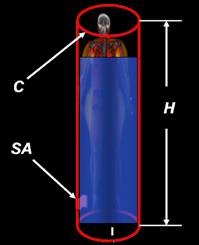About the Model
 Geometrical Concept
Geometrical Concept
Any index that serves as a proxy for percent total body fat is combining measures
that identify the geometry of the human body. For example, body mass index (BMI),
is developed by approximating the human body by a cylinder [ 1 ]. Similar to this concept, the developed formulas housed within this program apply
elliptical models to capture human body geometry.
Body Roundness Index
 First introduced in 1609 by the German astronomer Johannes Kepler to quantify the
circularity of planetary orbits, the degree of roundness of anellipse is characterized
by a non-dimensional value referred to as eccentricity [ 2 ]. Eccentricity valuesforan ellipse range from 0 to 1. Values closer to zero indicate
that the ellipse is morecircular in shape and values closer to one are represented
by tall narrow ellipses. Because the eccentricity of the human body ranged from 0.95
to 1, it is difficult to differentiate between different eccentricities without comparing
numbers with high decimal place values. To decrease this burden, we mapped eccentricity
to values between 1-20, where 1 represents more narrow body types and 20 represents
more round body types. We refer to these values as the body roundness index (BRI) .
First introduced in 1609 by the German astronomer Johannes Kepler to quantify the
circularity of planetary orbits, the degree of roundness of anellipse is characterized
by a non-dimensional value referred to as eccentricity [ 2 ]. Eccentricity valuesforan ellipse range from 0 to 1. Values closer to zero indicate
that the ellipse is morecircular in shape and values closer to one are represented
by tall narrow ellipses. Because the eccentricity of the human body ranged from 0.95
to 1, it is difficult to differentiate between different eccentricities without comparing
numbers with high decimal place values. To decrease this burden, we mapped eccentricity
to values between 1-20, where 1 represents more narrow body types and 20 represents
more round body types. We refer to these values as the body roundness index (BRI) .
The body roundness based prediction models of total percent body fat and total visceral
adipose tissue.
Several large databases that contained total percent body fat and MRI assessed visceral
adipose tissue volume were utilized to develop models that use body roundness to predict
body fat and visceral adipose tissue mass. As a stand-alone prediction index, the
BRI outperforms traditionally applied indices such as BMI, waist circumference, and
hip circumference. The models additionally improve accuracy of prediction by including
the effects of age, height, race, gender, and weight.
The geometrical measurements (height, waist circumference, and hip circumference) were applied to output your BRI and the generation of your personalized elliptical graph. The green zone that depicts healthy body roundness index were determined from published healthy body fat cutoffs [ 3 ] and a data-generated formula relating body fat and BRI.
References
- Heymsfield, S.B., et al., Body circumferences: clinical implications emerging from a new geometric model. Nutr Metab (Lond), 2008. 5: p. 24.
- Kepler, J., Astronomia nova. 1609, (Pragae).
- Gallagher, D., et al., Healthy percentage body fat ranges: an approach for developing guidelines based on body mass index. Am J Clin Nutr, 2000. 72(3): p. 694-701.